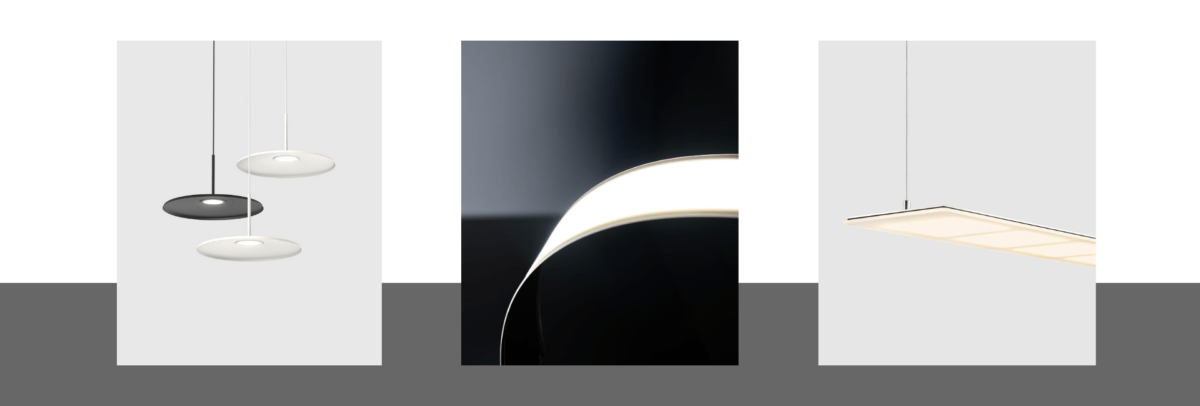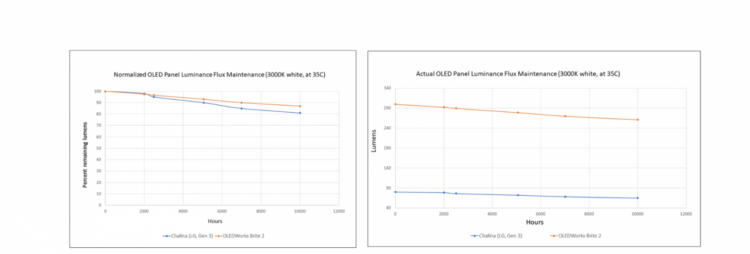
By Michael Boroson, CTO OLEDWorks
Three questions often asked about OLED lighting are how it compares to LED lighting on product longevity, energy efficiency, and cost. There’s a lot of misconception around OLED lighting performance, so it’s time to set the record straight.
Lifetime
From the start, OLEDWorks understood that lifetime for solid state lighting was one of its most important properties. With LED lighting boasting lifetimes of 50,000 hours or more, we knew that shorter lifetimes would be a significant barrier to OLED lighting adoption.
For that reason, we’ve developed the unique high OLED stack approach to OLED lighting that none of our competitors did. While some were making and selling OLED lighting panels composed of a maximum of 2 or 3 OLED stacks, our team introduced the Brite family of OLED lighting panels composed of 6 OLED stacks.
More stacks mean better lifetime. The current Brite 3 family of OLED lighting panels has a lifetime of over 100,000 hours. Due to our unique approach, lifetime is a non-issue in choosing between OLED and LED lighting.
Energy Efficiency
It’s true: LED light sources are more efficient than current OLED lighting panels. But when comparing the energy efficiency of OLED lighting to LED lighting, it is ultimately the energy required to light the specific task and/or space that matters. Therefore, it’s important to focus on the application-specific energy efficiency, rather than simply a comparison of the light source efficiency or even the luminaire efficiency.
How OLEDs and LEDs Produce Light
LEDs are tiny, highly concentrated light sources, well suited for creating beams of intense light required in automotive headlamps, spotlights, flashlights and other high-intensity, focused lighting applications. To make LEDs useful for general lighting or other low intensity applications, the LED light must be diffused, spread and homogenized, lowering the energy efficiency of the ultimate delivered light.
In contrast, OLED lighting panels are inherently highly homogeneous and low glare, such that the OLED lighting panel energy efficiency is the same as the delivered light efficiency. This effect is so significant that in some applications, such as automotive taillights, the OLED lighting solution is both more homogeneous and more energy efficient than the LED lighting solution. In general lighting, it is the combination of OLED and LED lighting that will deliver the highest ultimate application specific energy efficiency. By taking advantage of the strengths of each technology, the lowest energy consumption and most human-centric lighting solutions can be achieved.
OLED Light Yesterday, Today, and Tomorrow
Today the Brite 3 family of OLED lighting panels delivers a highly homogeneous, low glare, high CRI, human-centric light at 85 lm/W. This is more than twice the energy efficiency of the first Brite family of OLED lighting panels introduced in 2014. We are currently working on a Brite 4 family of OLED lighting panels with a target energy efficiency of over 100 lm/W, and we believe that over the next several years as light extraction efficiency and OLED materials improve, an ultimate energy efficiency of as much as 170 lm/W is possible.
Cost
Finally, on the question of cost, one must again compare the ultimate application cost. As a new technology that is still in the early but growing stage of volume manufacturing, OLED lighting panels are more expensive than LED light sources, just as early LED lamps were significantly more expensive just a few years ago before volumes grew significantly.
While it is true that OLED panels cost more than LED bulbs, it is also true that the cost of a luminaire made with OLED lighting panels is closer in cost to an LED luminaire than the cost of the base light sources themselves. Since the OLED luminaire does not require diffusers, homogenizers, heat sinks and other components used in LED luminaires, OLED luminaires require fewer components and less assembly than their LED counterparts.
The Bottom Line
With these key misconceptions put to rest, it’s clear that OLED light is not the light source of a distant future — OLED is ready now. OLED is efficient, healthy, built to last, good for the environment, and the prices continue to become even more competitive. With the continued advances of solid-state lighting, OLED and LED can be used to complement each other and create human-centric lighting that’s as good for the business as it is for its employees.



